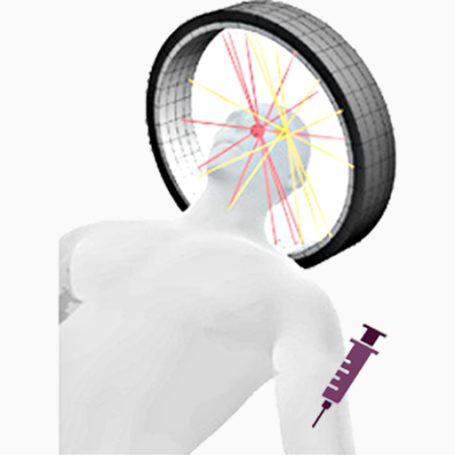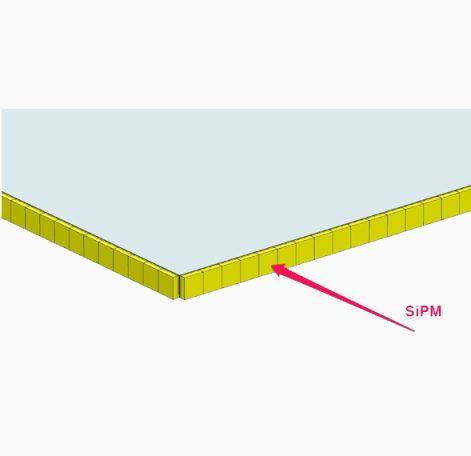
Dr. José Maria Benlloch Baviera
Director of the Institute of Instrumentation for Molecular Imaging (i3M - CSIC / UPV)
In the 4D-PET project, technologies have been developed that allow obtaining the three-dimensional (3D) impact point of a gamma ray used in positron emission tomography (PET) in an extensive detector with a submillimeter resolution and, in addition, measure the time in which said impact occurred with great precision (better than 200 picoseconds).
4D-PET
PROJECT
In medicine, it is often possible to determine if an organ is not working properly by examining its structure, as there is a strong relationship between form and function. In cases of traumatic injury, the loss of form is directly linked to the loss of function. However, in many other situations, it is not possible to determine the functionality of a tissue or organ just by looking at its internal structure.
Nuclear Medicine uses molecules with radioactive atoms to track their location in the body, similar to a GPS. Gamma rays, which have higher energy than X-rays, are emitted by these radioactive atoms and can pass through the body without interacting with it. This allows external gamma ray detection cameras to register them.
Positron Emission Tomography (PET) is a Nuclear Medicine image modality that is widely used in oncology, neurology and cardiology studies. The main concept behind PET is that the labeled substance with the radioisotope injected in the patient acts as a tracer for a specific physiological process. As a result, the area of the image where the radioisotope-labeled substance has accumulated appears bright like a light bulb.
This technology provides valuable insights into the functioning of organs and physiological processes within the body. After injection, the positrons emitted from the tracer will annihilate when it encounters an electron in its surroundings and as a result two photons will be obtained traveling in opposite directions at 511keV (see figure 1).
Therefore, in order to obtain the radiotracer map inside the body, that is a functional tomographic image after the reconstruction process, the following will be needed:
1. Arrival time of the photons in the detectors to discern what possible annihilation they come from (windows of typically a few nanoseconds). If we also have relative temporal information between the two photons coming from the same annihilation (order of
hundreds of ps allowed by current technology), we can also improve the contrast in the image. This is known as time-of-flight information (TOF).
2. The three-dimensional position of the photons in the detector to correctly assign the arrival trajectory of the photons (x,y and Depth of interaction or DOI).
3. The energy of the incident photons to ensure that they come from an annihilation
process. Positron Emission Tomography (PET) is an extremely sensitive imaging technique that can detect very small quantities of molecules. This sensitivity is crucial because it allows fo accurate measurement without disrupting the body's normal functioning. Additionally, it helps identify potential toxic substances when present in excess, preventing harmful effects. Most PET cameras use scintillation detectors, which emit light when stimulated by gamma radiation. The emitted light is then collected as pulses for further analysis.
Figure 1. Positron emission by a 18F nucleus and its subsequent annihilation with an electron in the body. The two generated photons γ1 and γ2 are emitted with the same energy (511 keV), at the same instant and in the same direction but in opposite directions. In the figure, the PET system consists of multiple modules capable of coincidentally detecting the photons generated by the annihilation.
The main objective of the 4D-PET ERC Advanced Grant is to develop an innovative PET scanner based in a new detector concept that stores 3D position and time of every single gamma interaction with unprecedented resolution. 4D-PET aims to fully exploits Time Of Flight (TOF) information to obtain a better image quality and to increase scanner sensitivity.
GAMMA-RAY 4D-PET DETECTOR TECHNOLOGY
The gamma rays produced by the annihilation of a positron and an electron have an energy of 511keV. In order to stop and detect the gamma rays thick scintillator crystals (~2 cm) are required. This implies that it is important also to determine the Depth Of Interaction (DOI) of the gamma ray inside the crystal (see figure). Good DOI resolution becomes essential especially when the detectors are place very near the object to be examined due to the parallax error (see figure).
The main challenge of 4D-PET is to design a new detector technology able to provide not only the 3D (X, Y and DOI) impact position of each gamma ray inside the detector block, but also the arrival time of the impact with excellent resolution. In the framework of the project several detector technologies and topologies have been investigated
HORIZONTAL SLABS:
This configuration consists of a stack of several slabs or semi-monolithic crystal blocks, each of about 3mm thickness. This configuration will provide a discrete DOI information, as the slab where the interaction will occur will be easily determined, a continuous X-Y information inside the slab as the light will be shared among the 3x3mm2 SiPMs at the crystal edges.
Horizontal Slabs with lateral readout was the original solution for achieving 4D-PET resolution and were studied at the beginning of the project. The drawback of this technology was the cost of the individual detectors.
A patent was filed and results published.
Characterization of a High-Aspect Ratio Detector With Lateral Sides Readout for Compton PET https://doi.org/10.1109/trpms.2020.3006862
Building blocks of a multi-layer PET with time sequence photon interaction discrimination and double Compton camera https://doi.org/10.1016/j.nima.2018.03.076
Roadmap toward the 10 ps time-of-flight PET challenge. https://doi.org/10.1088/1361-6560/ab9500
Improving PET sensitivity with a Compton algorithm. https://doi.org/https://doi.org/10.1088/1742-6596/931/1/012012
Characterization of LYSO and CeBr3 Detectors with Lateral Sides Readout for a Multilayer Compton-PET. https://doi.org/10.1109/nss/mic42101.2019.9059991
VERTICAL SLABS:
Vertical scintillating crystal Slabs was the final adopted design, due to simplicity and lower costs, to build the scanner prototypes. In this configuration, the slab hit defines one spatial dimension. The other 2 spatial dimensions are determined through the light distribution in the SIPM matrix at the bottom edge. We have obtained spatial resolutions in the order of a millimeter in the 2D SiPM matrix and 5mm in the DOI. Resolution in the arrival time of the gamma-rays is around 250ps. This topology has the advantage to have a continuous measurement of the DOI and a reduced number of photo-sensors to read a complete detector. The calculation of 2D position inside the vertical slab is done using neural networks.
This technology has been used in three PET system prototypes: whole-body, small animal and brain-size, using different slab sizes and configurations.
3 patents have been filed and the technology has been partly (for some applications) transferred to a Spanish company.
Results were published including two PhD theses.
PET Detector based on a Semi-Monolithic Crystal with DOI and TOF Capabilities. https://doi.org/10.1109/nss/mic42677.2020.9508047
Towards 100 ps PET Detectors Suitable for High-Resolution Brain Mouse Imaging. https://doi.org/10.1109/nss/mic42677.2020.9507997
Timing evaluation of a PET detector block based on semi-monolithic LYSO crystals. https://doi.org/10.1002/mp.15318
PET detector block with accurate 4D capabilities. https://doi.org/10.1016/j.nima.2017.11.002
METACRYSTALS
We also developed metacrystal technology. In this configuration, a sandwich is made by alternating thin layers (about 200 microns) of high density scintillating crystals and thin layers of low density but very fast scintillating crystals. The high-density material stops the gamma-rays and the fast crystal provides the timing information. The combination of both in pixels and layers improves the temporal response (in comparison with classical detector technologies) without a significant lose in sensitivity. This is a very promising technology but not mature.
2 patents have been filed.
Modeling brain-dedicated PET systems using metascintillators for optimized ToF capability. https://doi.org/10.36227/techrxiv.23699694.v1
Exploiting Cherenkov Radiation With BGO-Based Metascintillators. https://doi.org/10.36227/techrxiv.21388863.v1
A novel metascintillator approach for ultra-fast timing in Positron Emission Tomography, https://doi.org/10.1109/nss/mic42677.2020.9508015
Metascintillators: New Results for TOF-PET Applications. https://doi.org/10.1109/trpms.2022.3161473
A proof-of-concept of cross-luminescent metascintillators: testing results on a BGO:BaF2 metapixel. https://doi.org/10.1088/1361-6560/acac5f
Metascintillators for ultra-fast gamma detectors: a review of current state and future perspectives. https://doi.org/10.1109/trpms.2021.3069624
Unlocking Hidden Dimensions:
Explore the Future with 4D-PET Scanner
.
,
,
Necesitamos su consentimiento para cargar las traducciones
Utilizamos un servicio de terceros para traducir el contenido del sitio web que puede recopilar datos sobre su actividad. Por favor revise los detalles en la política de privacidad y acepte el servicio para ver las traducciones.









